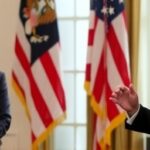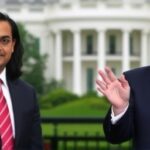In a dramatic escalation of tensions in the Western Hemisphere, the United States has deployed over 5,000 troops and sophisticated military hardware to strategic bases in the Caribbean, spotlighting Secretary of State Marco Rubio‘s aggressive campaign against Venezuela’s Maduro regime. Critics from both sides of the aisle are questioning the feasibility and risks of Rubio‘s push for regime change, as whispers of potential U.S. intervention grow louder under the Trump administration.
Rubio‘s High-Stakes Diplomacy Ignites Political Firestorm
Secretary of State Marco Rubio, a vocal critic of Venezuelan President Nicolás Maduro for years, has positioned the Trump administration’s foreign policy squarely against the socialist government in Caracas. Rubio’s strategy, which emphasizes economic sanctions, diplomatic isolation, and now a visible U.S. military buildup, aims to force regime change by crippling Maduro’s hold on power. However, this approach is drawing sharp scrutiny from lawmakers and international observers who fear it could lead to unintended consequences, including regional instability or even armed conflict.
Recent reports from the Pentagon indicate that the deployments include F-35 fighter jets stationed at Joint Base Andrews and naval assets repositioned to Guantanamo Bay, Cuba, just 90 miles from Venezuelan shores. These moves, Rubio argues, serve as a deterrent against Maduro’s alleged human rights abuses and ties to foreign adversaries like Russia and Iran. ‘The time for half-measures is over,’ Rubio stated during a press briefing last week. ‘Venezuela’s people deserve freedom, and the U.S. will stand with them against tyranny.’
Yet, the political backlash is mounting. Democratic Senator Chris Murphy of Connecticut lambasted the strategy on the Senate floor, calling it ‘a reckless escalation that echoes the failures of past interventions.’ Republicans, too, are divided; some, like Senator Rand Paul, warn that Rubio’s Venezuela fixation distracts from domestic priorities. Polls from Quinnipiac University show that only 42% of Americans support increased U.S. military involvement in Latin America, down from 55% in 2019.
Rubio’s personal stake in this issue adds emotional weight. As a Cuban-American whose family fled Castro’s regime, Rubio has long viewed Maduro’s Venezuela as a modern echo of communist oppression. His appointment as Secretary of State in the Trump administration was seen as a signal of hardline policy toward the region. Under Rubio’s guidance, the U.S. has imposed over 200 sanctions on Venezuelan officials since 2017, freezing assets worth billions and targeting key oil revenues that prop up Maduro’s government.
Despite these efforts, Maduro remains in power, bolstered by elections widely dismissed as fraudulent by the U.S. and allies like the European Union. Rubio’s campaign has included recognizing opposition leader Juan Guaidó as interim president in 2019—a move that initially galvanized international support but has since lost momentum as Guaidó’s influence wanes.
U.S. Military Buildup Signals Shift Toward Overt Pressure
The U.S. military’s escalating presence in the Caribbean marks a pivotal shift from covert support to overt posturing. Defense Secretary Lloyd Austin, in coordination with the Trump administration, authorized the deployment of the USS Gerald R. Ford carrier strike group to patrol international waters off Venezuela’s coast. This includes approximately 2,500 sailors and airmen, alongside drone surveillance systems capable of real-time monitoring of Venezuelan military movements.
According to leaked documents obtained by The Washington Post, the buildup is part of ‘Operation Liberty Shield,’ a classified initiative to prepare for humanitarian contingencies or direct threats to U.S. interests. Experts estimate the operation costs upwards of $500 million monthly, drawing funds from the Pentagon’s contingency budget. Satellite imagery from Maxar Technologies shows increased activity at U.S. bases in Puerto Rico and the U.S. Virgin Islands, with C-17 transport planes ferrying armored vehicles and munitions.
Rubio has defended the military posture as essential for regime change. In an op-ed for The Wall Street Journal, he wrote, ‘A strong U.S. military presence reassures our allies and sends a clear message to Maduro: your days are numbered.’ The Trump administration echoes this sentiment, with President Trump tweeting last month, ‘Venezuela’s dictator is on borrowed time—America won’t stand by while socialism destroys another nation.’
However, the deployments have alarmed neighboring countries. Colombia, a key U.S. ally, has expressed concerns over refugee flows, with over 1.8 million Venezuelans already crossing its border amid economic collapse. Brazilian President Jair Bolsonaro has called for multilateral action through the Organization of American States (OAS), but tensions with Rubio’s unilateral approach are evident. ‘We support democracy, but not at the cost of war,’ a Brazilian foreign ministry spokesperson said.
Intelligence assessments from the CIA highlight Maduro’s vulnerabilities: hyperinflation exceeding 1,000,000% in 2018 has left 96% of Venezuelans in poverty, per UN data. Yet, the regime’s control over the military and security forces, backed by Russian Spetsnaz trainers, complicates any regime change scenario. Rubio’s strategy banks on internal dissent, with reports of defections among Venezuelan generals surfacing in recent weeks.
Trump Administration’s Broader Vision for Latin America
Under the Trump administration, Rubio’s Venezuela campaign fits into a larger geopolitical chessboard aimed at countering Chinese and Russian influence in the Americas. The U.S. has ramped up aid to opposition groups, funneling $100 million through USAID for food and medical supplies since 2020. This soft power complements the hardline military stance, creating a dual-track approach to regime change.
White House officials, speaking anonymously, reveal that Rubio meets weekly with National Security Advisor Robert O’Brien to refine tactics. The administration’s ‘maximum pressure’ doctrine, first applied to Iran, now targets Venezuela’s oil sector. Chevron, the last major U.S. oil firm operating there, faces pressure to exit, potentially slashing Maduro’s revenues by 30%.
Critics argue this isolates the U.S. diplomatically. The UN Security Council has rejected multiple U.S. resolutions on Venezuela, with China and Russia vetoing efforts. European nations, while supportive of sanctions, prefer negotiation via the Lima Group. Rubio’s dismissal of talks as ‘appeasement’ has strained alliances; French President Emmanuel Macron recently urged ‘de-escalation’ in a call with Trump.
Domestically, the strategy boosts Rubio’s profile among hawkish Republicans but risks alienating moderates. A recent Gallup poll indicates 58% of GOP voters favor regime change in Venezuela, compared to 35% of independents. Florida’s Cuban-American community, a key voting bloc, rallies behind Rubio—exit polls from 2020 showed 60% support for his stance.
The economic angle is stark: Venezuela’s GDP has shrunk 75% since 2013, per IMF figures, fueling migration crises across the hemisphere. Rubio advocates for a post-Maduro economic revival plan, including $50 billion in reconstruction aid tied to democratic reforms.
International Reactions and Risks of Escalation
The global community watches warily as Rubio’s Venezuela push unfolds. Russia, a major arms supplier to Maduro, has dispatched warships to the region, prompting U.S. Navy intercepts. Iranian tankers delivering fuel have been seized by U.S. forces, escalating tit-for-tat actions. ‘This is a proxy conflict with global stakes,’ warns Brookings Institution analyst Michael O’Hanlon.
In Latin America, reactions vary. Mexico and Argentina advocate dialogue, while Peru and Chile align with U.S. goals. The OAS, under Secretary-General Luis Almagro—a Rubio ally—has suspended Venezuela’s membership, isolating it further.
Human rights groups like Amnesty International decry the military buildup’s humanitarian toll. ‘Sanctions have exacerbated suffering without toppling the regime,’ says executive director Erika Guevara-Rosas. Over 7 million Venezuelans have fled since 2015, straining global resources.
Rubio counters with data: U.S. sanctions have frozen $7 billion in assets, funding opposition efforts. Yet, a Council on Foreign Relations report cautions that military intervention could cost $100 billion and 10,000 lives, citing Iraq parallels.
As deployments continue, whispers of special operations—covert aid to dissidents—circulate. Rubio’s endgame: a tipping point where Maduro’s elites defect, paving regime change without full invasion.
Path Forward: Balancing Pressure and Diplomacy
Looking ahead, Rubio’s Venezuela strategy hinges on leveraging U.S. military might to force negotiations or collapse. The Trump administration plans a summit with regional leaders next month to coordinate pressure, potentially including cyber defenses against Venezuelan hacks on U.S. infrastructure.
Analysts predict a 2025 timeline for change, with oil prices—currently $80 per barrel—squeezing Maduro further. If successful, regime change could stabilize energy markets and democracy in the region. Failure risks a prolonged standoff, drawing in adversaries and testing alliances.
Rubio remains defiant: ‘History will judge us not by our caution, but our courage.’ As troops dig in, the Caribbean teeters on the edge of transformation—or turmoil.









